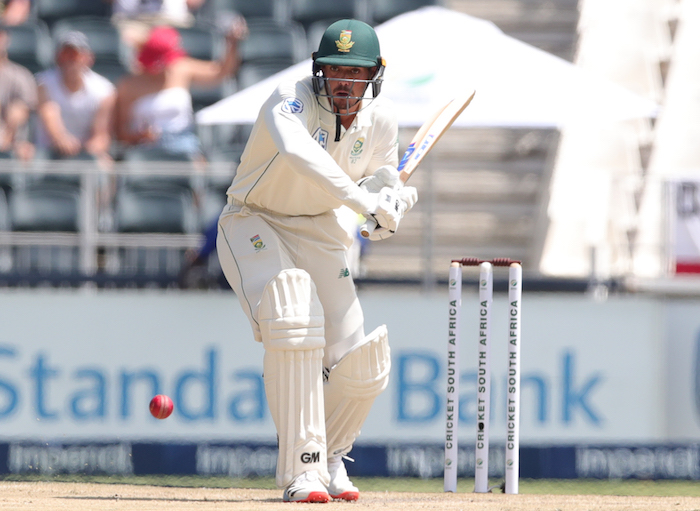The Proteas had a bit of a horror show with the bat against England, failing to reach the 300-run mark in each of their eight innings against the visitors. JOHN GOLIATH looks at ways they can remedy their ailments with willow in hand.
Quinton de Kock needs more responsibility
- I’ve been advocating for South Africa’s wicket-keeper to abandon the gloves and play solely as a batsman. De Kock is South Africa’s best player with bat in hand – by a country mile – and his talents are wasted at Nos 6 and 7, because he invariably has to bat with the tail. Obviously, he has done that successfully, coming in at the back end of an innings and scoring quick runs with the lower order. His record is testimony. But he is a far better player than that, and a guy who needs to be challenged. No 5 seems to be a sweet spot for De Kock, because he can come in and score big hundreds and double hundreds, but also score quickly if wickets are tumbling around him or the opportunity is there to take the game away from the opposition like Ben Stokes did in Cape Town and Port Elizabeth. That’s how good he really is. Someone needs to sit him down and say, ‘You are better than the odd quick-fire 60, 70 or 80.’ De Kock has the ability to be the world’s best batsman, in all forms of the game. It’s time to give him that responsibility.
England in SA: Proteas report cards
Application, application, application, but …
- The Proteas’ two best innings of the series was arguably in the fourth innings at Newlands and the Wanderers. It really doesn’t say much when the totals were 248 and 274, respectively, but they were great examples of South Africa’s batting extremes. In Cape Town they applied themselves beautifully, and were about 40 minutes away from an unlikely draw when they were skittled out. At the Wanderers, on the other hand, they played their shots in search of a world-record score to tie the Test series. They looked good at one stage, but one shot too many was their undoing. Mark Boucher’s men need to find that sweet spot in the middle, and combine application with positive intent. You have to make sure you preserve your wicket, but also put the bowlers and fielders under pressure by rotating the strike and punishing bad balls. You can’t allow bowlers to dictate, but you mustn’t throw you wicket away either.
Don’t lose concentration right before or after breaks
- This is where the Proteas’ inexperience came to the fore. They lost wickets at crucial times in this past series against England. Losing a wicket at the end or the start of a session is criminal, because it sometimes brings a massive swing in the momentum of the match. Breaking a big partnership before a break gives the opposition bowlers renewed optimism after toiling for most of the session, and also a chance of having a crack at the new batsman. At the same time, it deflates the batting dressing room as they would have had targets in mind, while the new batsman wouldn’t have wanted his appetite spoiled with the prospect of having to go out and bat shortly before a break. It’s important that when a batting side controls a session, they stick the knife in deep. You don’t want to throw that mental advantage away by giving the opposition a lifeline.
READ: Silver linings from series defeat
Defending with soft hands is essential to a top Test innings
- This is something batting consultant Jacques Kallis would have worked on with the majority of the Proteas players since his appointment. He was the king of defending the ball right under his eyes with a dead bat. White-ball stars such as Rassie van der Dussen and Dwaine Pretorius went hard at the ball outside their off-stump in the first Test at SuperSport Park, which is something that gets you in trouble on the bouncy South African pitches. You could see in the last Test in Johannesburg that both players were playing the ball a lot later and under their eyes, while also trying to defend with soft hands. Playing with soft hands or a dead bat is essential on a seaming wicket, because it makes it harder for the edges to carry to catches behind the stumps. Close catchers also have less of a chance when a ball pops up off the bat.
Check players’ FC stats … but with a little twist
- Former Proteas spinner Robin Peterson reckons that batsmen who come from the coast are better equipped for Test cricket, because these players play on pitches that aren’t really conducive to stroke-play and don’t really come on to the bat. So, scoring runs is a bit of a grind. So he suggested that you have to investigate and check where South Africa’s batsmen score their runs in first-class cricket, but also in what sort of situation and against which bowling attack. Looking at a player’s average is just not enough, especially as many players also score heavily in semi-pro cricket. This seems like a bright idea, as it will certainly give a better indication of who has the temperament and technique to survive the challenges faced in Test matches.
Photo: Gallo Images







